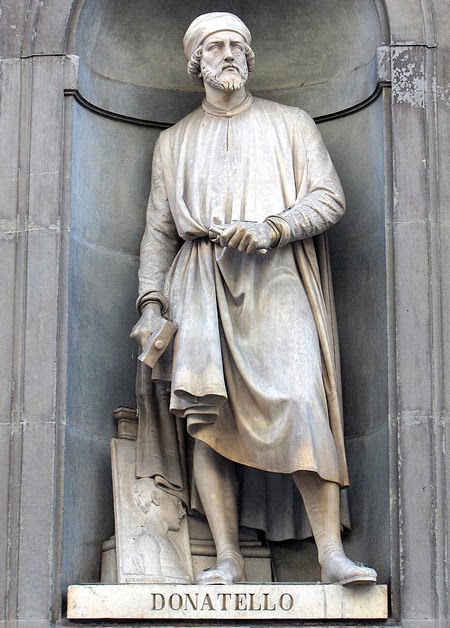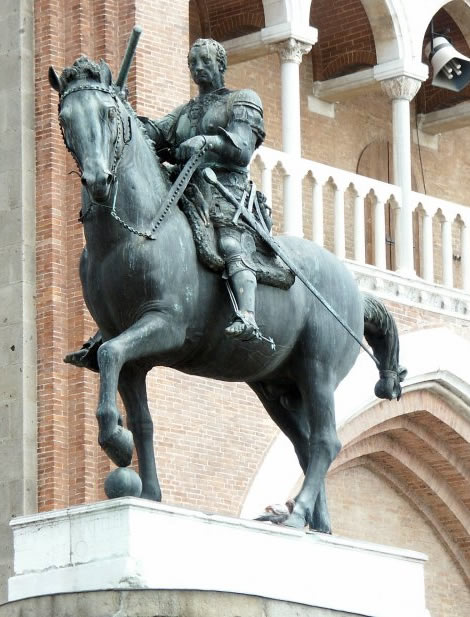 |
| Donatello |
Donato di Niccolode Bettto Bardi (Donatello) is one of the greatest and most famous Italian sculptors of the 15th century, whose work was greatly influenced by the early European Renaissance. He was born in Florence (or in its vicinities) between the years 1382 and 1387, in the family of Niccolò di Betto Bardi, a Florentine wool carder. He studied in the workshop of Lorenzo Ghiberti, a bronze sculptor, who in 1402 had won the competition to make the doors of the Florentine baptistery.
Donatello’s first works, the marble David and St. John the Evangelist for the cathedral façade, show the influence of Ghiberti and of the Gothic style. The young sculptor’s artistic development was greatly stimulated by his friendship with Filippo Brunelleschi, a sculptor and an architect, who later stayed with Donatello during his years of studies in Rome.
Most of his adult life was spent in Florence, where he worked under the patronage of first Cosimo, then Piero de’ Medici, but during the years 1444–55 he lived in Padua, commissioned to work on bronze statue of a famous Venetian condottiere, popularly called Gattamelata, who had died shortly before.
Donatello’s style may be described as classical realism: He had a strong proclivity to depict life as it is and, attempting to link between the medieval art and the classical antiquity, took great interest in the peculiarities of human body and facial expressions. (A closer study of the ancient models eventually taught Donatello to refrain from overly expressive radical realism.)
It is possible to divide Donatello’s work into two substyles: the pure realistic style and the neoclassical style, with great allusion to the Greco-Roman ideals. The statue of Mary Magdalene created for the Florentine baptistery in 1434 shows an old, skeletal, hairy woman, and Donatello’s King David, nicknamed Zuccone, or pumpkin (1427–35) (for his large, bold head), may be grouped under Donatello’s realistic style.
These works tend to reject the traditional iconography. On the contrary, the Triumph of Bacchus in Museo Borgello, Florence, the bronze David (c. 1469), and the half-bust of Selena on a bronze vase (Kensington Museum, London) imitate ancient art.
 |
| Equestrian statue of Gattamelata by Donatello |
The best of Donatello’s works, however, are those in which he followed his own ideas, which in many ways corresponded with the pursuits and innovations of the Italian humanists—a careful exploration of human body and psyche, the interrelationship between human beings, and the human interaction with nature and the higher spheres.
Donatello’s genuine interest in psychology and his desire to bring to light the inwardness of things are evident in the statue John the Baptist, exhibited in Santa Maria Gloriosa dei Frari (Venice), which he created in Padua; this extraordinary figure clearly shows new insight into psychological reality as constantly plagued by emotional anxieties.
Donatello is also credited with the invention of the schiacciato (“flattened out”) technique, a new mode of bas-relief, applied to his marble panel St. George Killing the Dragon (1416–17) and other works. The technique involved more shallow carving than was customary, which created a sharp contrast between bodies and surrounding landscape, making the relief more dependent on visual perception.
Donatello’s great fascination with human emotions continued throughout most of his work but was intensified after the artistic crisis he experienced during his last years in Padua. From the magnificent bronze David (influenced, apparently, by Etruscan figurines) to the dancing children in the relief of the Duomo di Prato (1434)—Donatello’s creations are lively, energetic, and gracious.
His works are rendered extraordinary for their individuality, and for their ability to create a dialogue between the composition and its onlooker. Donatello was said to treat human passions somewhat obsessively, more often than not showing them in repellent forms, as, for example, in the Entombment of Christ, a bas-relief made of painted plaster for the Church of St. Anthony in Padua.
The same expressiveness can be discerned in Donatello’s last work, which was finished by his pupil Bertoldo after the master’s death—two great bronze pulpits showing the Passion of Christ, work of tremendous complexity. The great Renaissance sculptor died in 1466, being once again employed by his old patrons the Medici, and was buried with great honors in the Church of St. Lorenzo, covered with the same bronze pulpits.
EmoticonEmoticon